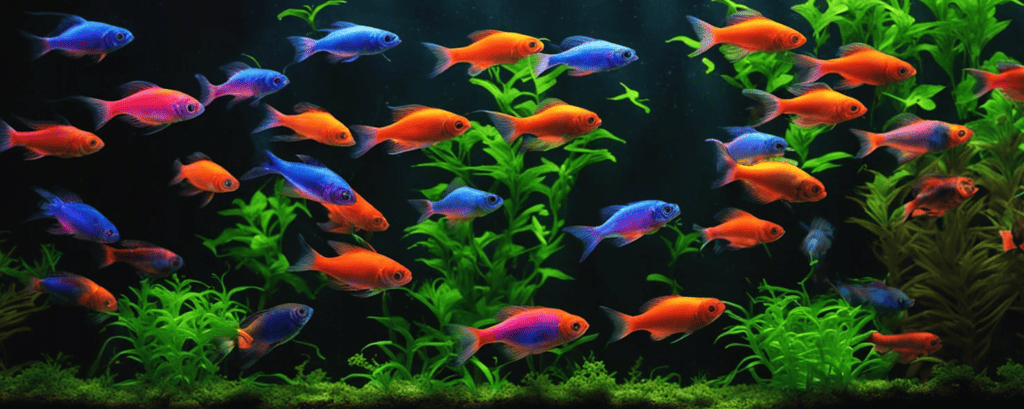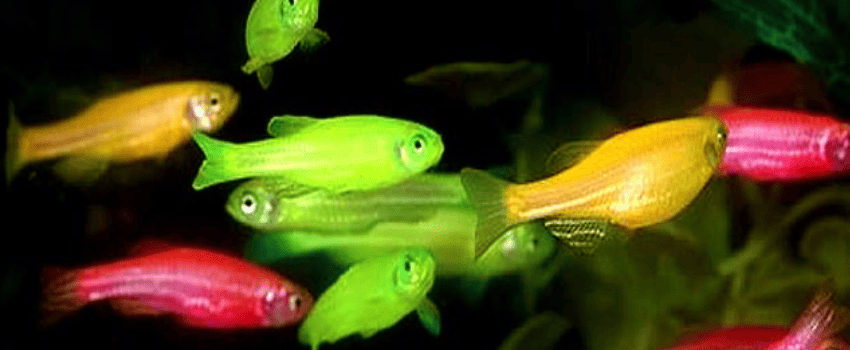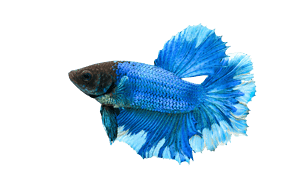The betta is one of the most popular freshwater aquarium fish species available.
Glofish are decorative fish that exist across a variety of species. This includes the betta, tetra, danio, and others.
Certain types of glofish can live with your betta, but others are not safe tank mates.
In the correct environment, peaceful glofish species can live with a betta. To make this work, you need to make both species feel safe. Ensure the water parameters are comfortable for everyone. Add lots of plants and decor, but use a large fish tank to avoid creating a cramped environment.

Table of Contents
Betta Behavior and Habits
A lot of fish keepers think every betta has an aggressive temperament.
In truth, they come with different personalities, just like other animals.
Betta fish do have territorial instincts, though. You must remember these instincts when introducing a potential betta tank mate.
Your betta needs to feel like they have control over its environment.
They need lots of space, good hiding spots, and consistent feeding times.
A thriving environment of bushy aquarium plants is critical too!
The care level for one betta fish is rather easy. But to give them a tank mate, you need a higher experience level.
The key to making this work is finding a betta with the correct temperament and perfecting the betta fish tank setup.
Here’s a more detailed betta fish care guide for your reference.
All About Glofish

Glofish have a unique appeal because of its beautiful fluorescent appearance.
Aquarists love them because they make community tanks pop.
As previously stated, glofish are not limited to one species.
The most suitable tank mate to live with a betta is the glofish tetra.
Danios are nippy and swim too fast. Barbs and betta fish stress one another out enormously.
Even glofish bettas are incompatible tank mates for other betta fish.
But glofish tetras are peace-loving and calm. They are unlikely to cause extra stress for your betta.
While betta fish are slow swimmers, the glofish tetra is much faster.
Their fast movements might startle your Siamese fighting fish at first, but everyone will adjust over time.
These tetras are small and unassuming, making them ideal tank mates for a betta.
On the other hand, tetras are schooling fish. To keep them happy, it’s best to get at least 6-7 fish for the glofish aquarium.
Your betta is more likely to feel like their territory is being threatened when they see so many fast-swimming fish.
Then again, the tetra being such an energetic fish is one more reason aquarists love them so much.
Creating a Safe Communal Aquarium

Tank Size and Filtration
The technical requirements for your new pets start with accepting a fish tank size upgrade.
To raise a single betta, all you need is a 5-gallon aquarium. Add 6-8 tetras, and you’re looking at a 30-gallon aquarium.
A tank of this size takes more resources and time to set up.
If you prefer, start with a glofish aquarium kit and make adjustments as needed for your betta.
We normally suggest using a gentle sponge filter for your betta. But keeping tetras with betta fish is more complicated as the tank is so much larger.
For this situation, test out a tetra internal filtration system. These are available on Amazon at the link.
Be sure to buy one correlating to the size of your aquarium.
The one linked above is for a 30-gallon tank. But these are available for 20-gallon or 45-gallon as well.
Keep an eye on your betta with this filtration system. Betta fish are not strong swimmers, so a strong current is harmful to them.
Plants and Decor

Just like your betta, glofish tetras love a planted aquarium.
Providing bushy plants is good for water quality and morale. Your fish have more to look at and be curious about.
Plants also help simulate your betta’s natural habitat, making them feel more comfortable.
This reduces aggression in the community tank.
Floating logs, driftwood, and caves are popular home aquarium decorations.
It is essential to provide enough hiding spaces for all your fish.
Your fish will have difficulty getting used to one another at first. Having secure hiding spots away from blue light and tank mates is helpful.
Be selective about decor, though. Betta fish often have long fins (and so do some glofish tetras), which snag easily.
Sharp or jagged edges are likely to cause tearing and infection.
A lot of aquarium decor sold online comes with some rough patches.
Keep sandpaper on hand and smooth the edges on new decor before putting it in the tank.
Water Parameters
Ideal Water Parameters for a Betta Fish Tank Include the following:
- Temperature: 78-80° degrees Fahrenheit (25.5-27° C)
- pH: 6.5-7.5
- Ammonia and Nitrite: 0 ppm
- Nitrate: < 40 ppm
- gH: 3-4 dGH (50-66.7 ppm)
- kH: 3-5 dKH (53.6-89.4 ppm)
- Minimum Tank Size: 5 Gallons
Betta fish have a narrow range of water requirements you need to follow.
Like most aquarium fish, your betta can tolerate water conditions slightly outside these ranges.
But the goal is to keep these values steady at all times.
You need to get a heater for the tank to keep the temperature up. Get a good filter to keep ammonia, nitrite, and nitrate levels down.
Remember, though, you need to ensure the water parameters in this tank are good for both the betta and the tetras.
Glofish tetras have their own set of needs.
| Temperature | 75-80° degrees Fahrenheit (24-27°C) |
| pH | 6.8-7.8 |
| Hardness | 2-10 dGH |
| Ammonia | 0 ppm |
| Nitrite | 0 ppm |
| Nitrate | <40 ppm |
Fortunately, there is a lot of overlap between the care requirements for glofish tetras and betta fish.
The important thing is to keep all these values in the sweet spot.
Here’s a list of the ideal water conditions to keep both species happy in their environment:
| Temperature | 78-80° degrees Fahrenheit (26-27°C) |
| pH | 6.8-7.0 |
| Hardness | 2-4 dGH |
| Ammonia | 0 ppm |
| Nitrite | 0 ppm |
| Nitrate | <40 ppm |
Maintaining Water Quality

The trick to maintaining good water conditions starts with keeping track of them.
Get the proper aquarium supplies, including a good thermometer and lots of water testing strips.
Glofish tetras usually only need a 25% water change 1-2 times per month. But betta fish need weekly partial water changes.
To keep waste down, start out with those weekly water changes. If you always have a clean aquarium, it’s okay to space out those water changes a little more.
Do frequent tests to make sure chemical levels aren’t getting out of control.
It’s also essential to clean your filter every month.
Some filters have parts you need to replace each month, so always read the instructions before setting one up.
Dietary Needs and Compatibility

Betta fish are carnivorous. They eat a combination of commercial pellets and frozen or freeze-dried foods.
Some favorites for betta fish include daphnia, bloodworms, and shrimp.
Meanwhile, glofish tetras are omnivorous. They also eat a variety of food types, including both dry and frozen products.
Betta fish pellets are purposefully made with high protein content. They must get this protein in their diet.
Feeding separate meals is an option, but it is not easy.
One method is to use a floating breeding box when it’s time to feed your fish.
Remove uneaten food after just a few minutes, then release the betta back into the tank.
Common Problems (and Solutions)

Aggressive Behavior
There’s a reason the betta is known as a territorial fish. They have instincts for keeping control over their environment.
Sometimes this comes out in nipping, flaring, and chasing their tank mates.
Despite their usually peaceful nature, certain glofish tetras also nip at tank mates.
This is partly because they are such fast swimmers, whereas betta fish are relatively slow.
As long as your pets are well-entertained and well-fed, they won’t be as likely to attack one another.
Providing extra decor, plants, and hiding places is a great way to reduce stress and aggression.
We will offer you one more piece of advice to avoid this problem: Pick your betta with care.
An extremely aggressive betta shows signs of their temperament even in the pet store.
Seek out a betta who doesn’t flare much or at all, is not charging at the glass, and looks healthy.
These are all good signs in a betta, meaning they have a relatively calm personality and won’t get sick easily.
They are less likely to cause problems with tank mates like glofish.
Filter Strength

We know betta fish are weak swimmers compared with glofish tetras.
Your tetras will be a bit disappointed, but the better choice here is to install the gentler filter.
Tetras can swim just fine in a weaker current, while a betta could get seriously hurt from a stronger one.
Keep in mind this is still a tricky aquarium to manage. Even doing everything right, your fish may not get along.
So have a backup plan. Invest in a second aquarium in case you need to move someone.
Tank dividers work too if you still want to use the one large aquarium.
Are Glofish and Betta Fish Good Tank Mates?
It’s not easy to keep a betta with a small school of glofish, but it is doable.
You need a larger tank than usual and plenty of decor for hiding.
Be prepared to do weekly water changes and test water quality on a regular basis.
Most importantly, create a contingency plan. If something goes wrong, where will you move your fish so they’re safe?
Read more about good tank mates for betta fish in this article!


